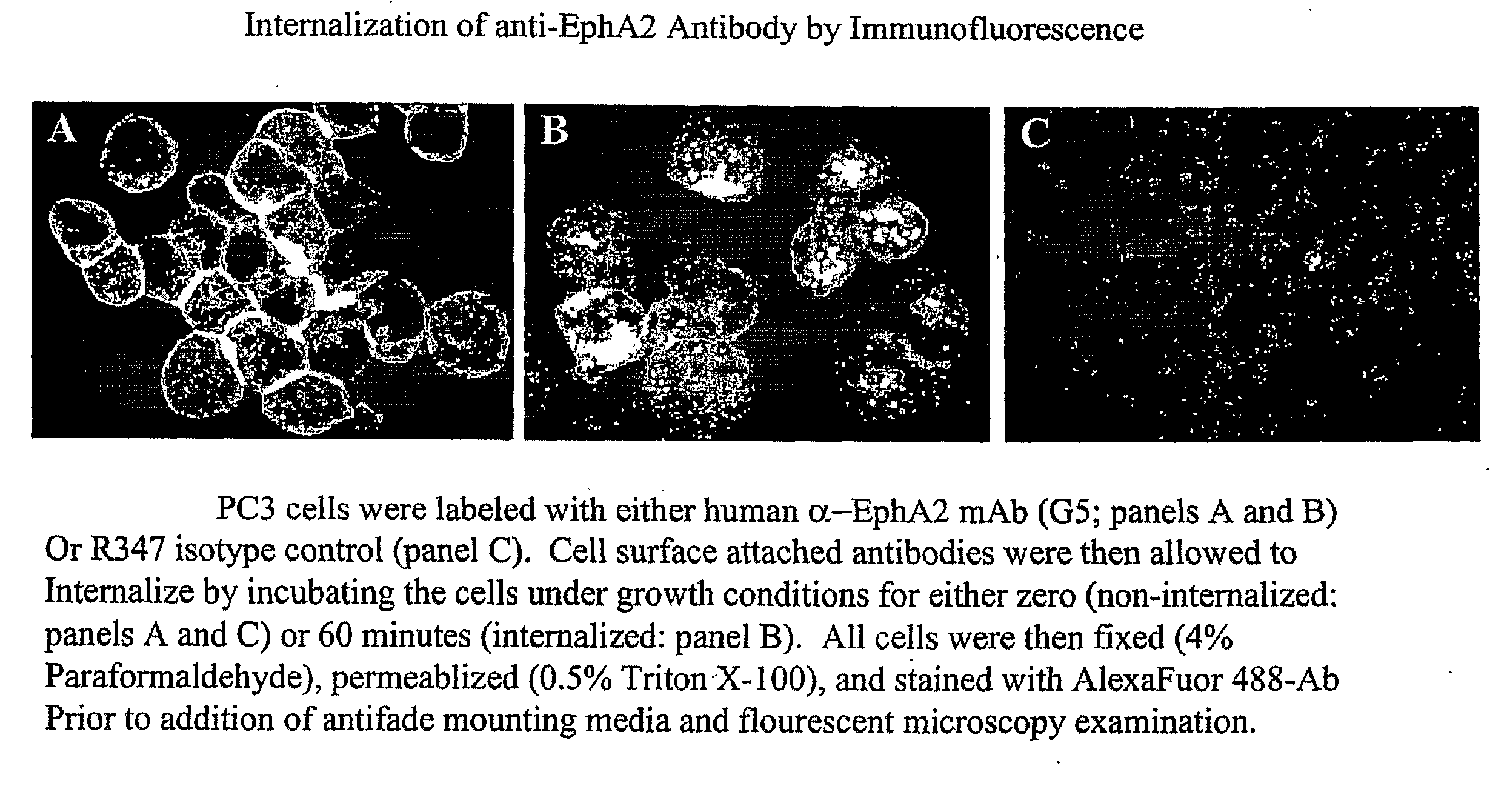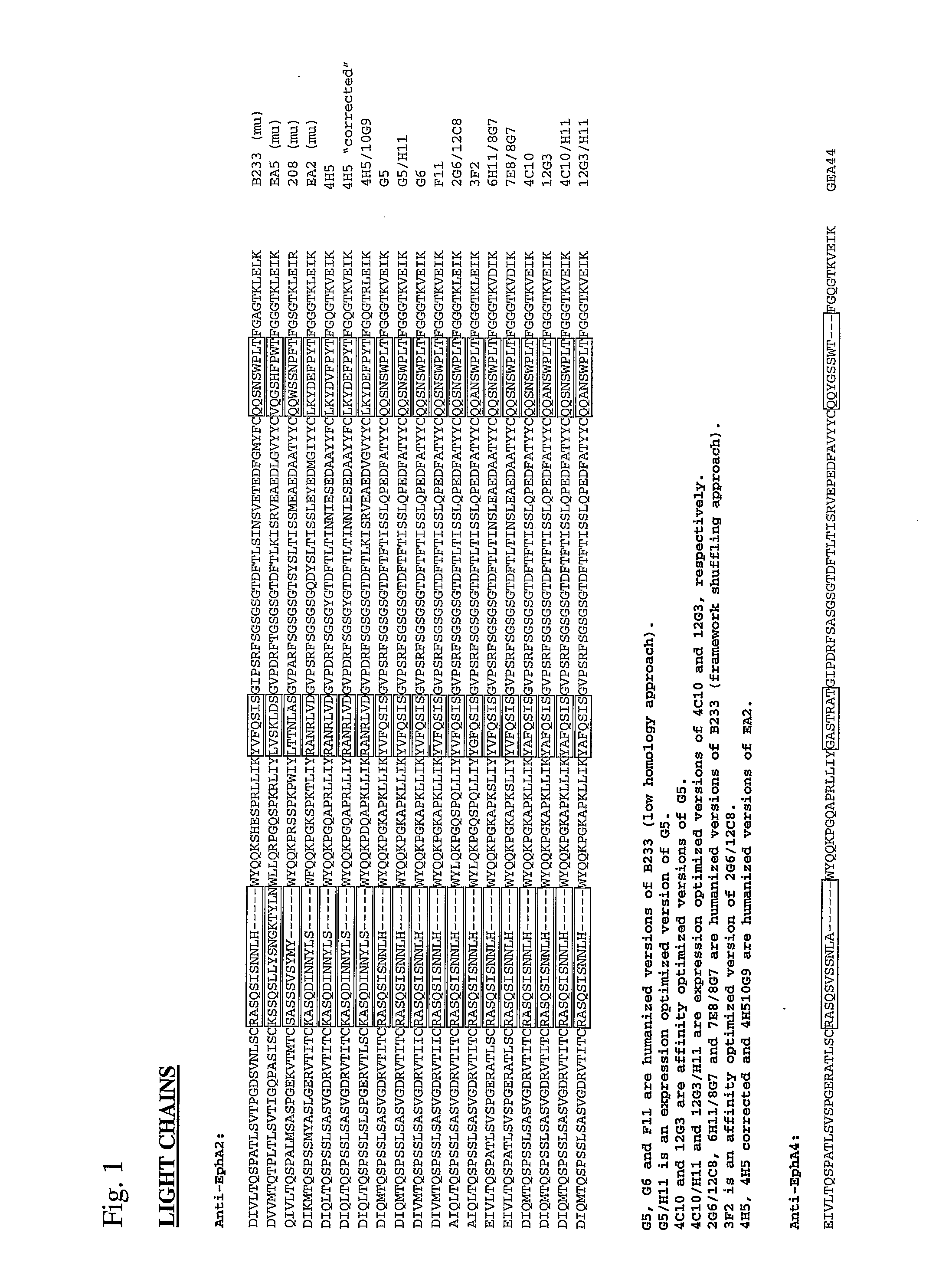Toxin conjugated eph receptor antibodies
a technology of eph receptor and conjugated eph receptor, which is applied in the field of toxic conjugated eph receptor antibodies, can solve the problems of increasing destruction, presenting serious side effects, and ineffective current treatment options, such as surgery, chemotherapy and radiation treatment, and the most life-threatening forms of cancer
- Summary
- Abstract
- Description
- Claims
- Application Information
AI Technical Summary
Benefits of technology
Problems solved by technology
Method used
Image
Examples
embodiment 1
3. The antibody or ADC of embodiment 1 further comprising a VL domain having an amino acid sequence of the VL domain of 12G3H11, B233, B208, B210, G5, 10C12, 4H5, 10G9, 3F2, 1C1, 1F12, 1H3, 1D3, 2B 12, or 5A8.
4. An EphA2 antibody or ADC comprising a complementarity determining region (CDR) having an amino acid sequence of a CDR of 12G3H11, B233, B208, B210, G5, 10C12, 4H5, 10G9, 3F2, 1C1, 1F12, 1H3, 1D3, 2B12, or 5A8, wherein the said antibody or ADC specifically binds to an EphA2 polypeptide.
embodiment 4
5. The antibody or ADC of embodiment 4, wherein the antibody or ADC comprises a VH CDR having an amino acid sequence of a VH CDR of 12G3H11, B233, B208, B210, G5, 10C12, 4H5, 10G9, 3F2, 1C1, 1F12, 1H3, 1D3, 2B12, or 5A8.
6. The antibody or ADC of embodiment 4, wherein the antibody or ADC comprises a VL CDR having an amino acid sequence of a VL CDR of 12G3H11, B233, B208, B210, G5, 10C12, 4H5, 10G9, 3F2, 1C1, 1F12, 1H3, 1D3, 2B12, or 5A8.
embodiment 5
7. The antibody or ADC of embodiment 5 further comprising a VL CDR having the amino acid sequence of a VL CDR of 12G3H11, B233, B208, B210, G5, 10C12, 4H5, 10G9, 3F2, 1C1, 1F12, 1H3, 1D3, 2B12, or 5A8.
8. The antibody or ADC of embodiment 5, wherein the antibody or ADC comprises a VH CDR1 having an amino acid sequence of a VH CDR1 of 12G3H11, B233, B208, B210, G5, 10C12, 4H5, 10G9, 3F2, 1C1, 1F12, 1H3, 1D3, 2B12, or 5A8.
9. The antibody or ADC of embodiment 5, wherein the antibody or ADC comprises a VH CDR2 having an amino acid sequence of a VH CDR2 of 12G3H11, B233, B208, B210, G5, 10C12, 4H5, 10G9, 3F2, 1C1, 1F12, 1H3, 1D3, 2B12, or 5A8.
10. The antibody or ADC of embodiment 5, wherein the antibody or ADC comprises a VH CDR3 having an amino acid sequence of a VH CDR3 of 12G3H11, B233, B208, B210, G5, 10C12, 4H5, 10G9, 3F2, 1C1, 1F12, 1H3, 1D3, 2B12, or 5A8.
PUM
| Property | Measurement | Unit |
|---|---|---|
| Volume | aaaaa | aaaaa |
| Volume | aaaaa | aaaaa |
| Mass | aaaaa | aaaaa |
Abstract
Description
Claims
Application Information
 Login to View More
Login to View More - R&D
- Intellectual Property
- Life Sciences
- Materials
- Tech Scout
- Unparalleled Data Quality
- Higher Quality Content
- 60% Fewer Hallucinations
Browse by: Latest US Patents, China's latest patents, Technical Efficacy Thesaurus, Application Domain, Technology Topic, Popular Technical Reports.
© 2025 PatSnap. All rights reserved.Legal|Privacy policy|Modern Slavery Act Transparency Statement|Sitemap|About US| Contact US: help@patsnap.com



